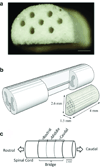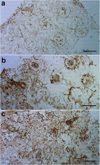Multifunctional, multichannel bridges that deliver neurotrophin encoding lentivirus for regeneration following spinal cord injury
- PMID: 22130565
- PMCID: PMC3237872
- DOI: 10.1016/j.biomaterials.2011.11.002
Multifunctional, multichannel bridges that deliver neurotrophin encoding lentivirus for regeneration following spinal cord injury
Abstract
Therapeutic strategies following spinal cord injury must address the multiple barriers that limit regeneration. Multiple channel bridges have been developed that stabilize the injury following implantation and provide physical guidance for regenerating axons. These bridges have now been employed as a vehicle for localized delivery of lentivirus. Implantation of lentivirus loaded multiple channel bridges produced transgene expression that persisted for at least 4 weeks. Expression was maximal at the implant at the earliest time point, and decreased with increasing time of implantation, as well as rostral and caudal to the bridge. Immunohistochemical staining indicated transduction of macrophages, Schwann cells, fibroblasts, and astrocytes within the bridge and adjacent tissue. Subsequently, the delivery of lentivirus encoding the neurotrophic factors NT-3 or BDNF significantly increased the extent of axonal growth into the bridge relative to empty scaffolds. In addition to promoting axon growth, the induced expression of neurotrophic factors led to myelination of axons within the channels of the bridge, where the number of myelinated axons was significantly enhanced relative to control. Combining gene delivery with biomaterials to provide physical guidance and create a permissive environment can provide a platform to enhance axonal growth and promote regeneration.
Copyright © 2011 Elsevier Ltd. All rights reserved.
Figures






Similar articles
-
Poly (D,L-lactic acid) macroporous guidance scaffolds seeded with Schwann cells genetically modified to secrete a bi-functional neurotrophin implanted in the completely transected adult rat thoracic spinal cord.Biomaterials. 2006 Jan;27(3):430-42. doi: 10.1016/j.biomaterials.2005.07.014. Epub 2005 Aug 18. Biomaterials. 2006. PMID: 16102815
-
Long-term characterization of axon regeneration and matrix changes using multiple channel bridges for spinal cord regeneration.Tissue Eng Part A. 2014 Mar;20(5-6):1027-37. doi: 10.1089/ten.TEA.2013.0111. Epub 2013 Dec 11. Tissue Eng Part A. 2014. PMID: 24168314 Free PMC article.
-
Regulated viral BDNF delivery in combination with Schwann cells promotes axonal regeneration through capillary alginate hydrogels after spinal cord injury.Acta Biomater. 2017 Sep 15;60:167-180. doi: 10.1016/j.actbio.2017.07.024. Epub 2017 Jul 19. Acta Biomater. 2017. PMID: 28735026
-
Viral vector-mediated gene transfer of neurotrophins to promote regeneration of the injured spinal cord.Prog Brain Res. 2004;146:451-76. doi: 10.1016/S0079-6123(03)46029-9. Prog Brain Res. 2004. PMID: 14699980 Review.
-
Neurotrophic factors for spinal cord repair: Which, where, how and when to apply, and for what period of time?Brain Res. 2015 Sep 4;1619:36-71. doi: 10.1016/j.brainres.2014.10.049. Epub 2014 Nov 1. Brain Res. 2015. PMID: 25451132 Review.
Cited by
-
Biomaterial-targeted precision nanoparticle delivery to the injured spinal cord.Acta Biomater. 2022 Oct 15;152:532-545. doi: 10.1016/j.actbio.2022.08.077. Epub 2022 Sep 8. Acta Biomater. 2022. PMID: 36087868 Free PMC article.
-
Conductive Hydroxyethyl Cellulose/Soy Protein Isolate/Polyaniline Conduits for Enhancing Peripheral Nerve Regeneration via Electrical Stimulation.Front Bioeng Biotechnol. 2020 Jul 3;8:709. doi: 10.3389/fbioe.2020.00709. eCollection 2020. Front Bioeng Biotechnol. 2020. PMID: 32719783 Free PMC article.
-
Matrix-based gene delivery for tissue repair.Curr Opin Biotechnol. 2013 Oct;24(5):855-63. doi: 10.1016/j.copbio.2013.04.007. Epub 2013 May 14. Curr Opin Biotechnol. 2013. PMID: 23680305 Free PMC article. Review.
-
Reducing inflammation through delivery of lentivirus encoding for anti-inflammatory cytokines attenuates neuropathic pain after spinal cord injury.J Control Release. 2018 Nov 28;290:88-101. doi: 10.1016/j.jconrel.2018.10.003. Epub 2018 Oct 6. J Control Release. 2018. PMID: 30296461 Free PMC article.
-
Spinal Progenitor-Laden Bridges Support Earlier Axon Regeneration Following Spinal Cord Injury.Tissue Eng Part A. 2018 Nov;24(21-22):1588-1602. doi: 10.1089/ten.TEA.2018.0053. Epub 2018 Oct 19. Tissue Eng Part A. 2018. PMID: 30215293 Free PMC article.
References
-
- David S, Aguayo AJ. Axonal elongation into peripheral nervous system "bridges" after central nervous system injury in adult rats. Science. 1981;214:931–933. - PubMed
-
- Xu XM, Guenard V, Kleitman N, Bunge MB. Axonal regeneration into Schwann cell-seeded guidance channels grafted into transected adult rat spinal cord. J Comp Neurol. 1995;351:145–160. - PubMed
-
- Geller HM, Fawcett JW. Building a bridge: engineering spinal cord repair. Exp Neurol. 2002;174:125–136. - PubMed
Publication types
MeSH terms
Substances
Grants and funding
LinkOut - more resources
Full Text Sources
Other Literature Sources
Medical
Research Materials

